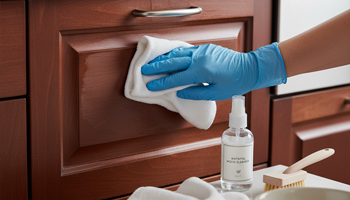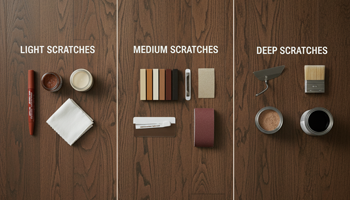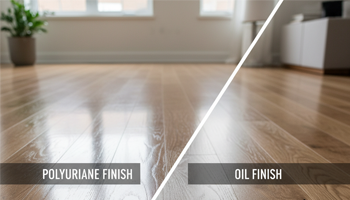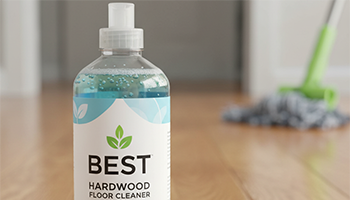How to Clean Greasy Wood Kitchen Cabinets Without Damaging the Finish
Kitchen grease is a slow, sneaky invader—one day your cabinets look fine, the next they feel tacky and look dull. The good news: you can remove cooking grease from wood cabinets without stripping the finish or risking swelling, warping, or discoloration. Below you’ll find science-backed methods, a clear “grease severity scale,” and pro-level tips learned on real jobs.
Prevention Callout
Always run your stove vent every time you cook. Capturing airborne oil particulates at the source can cut perceived grease fallout by ~60–70% in typical home kitchens. If you don’t have a hood, even a basic range hood helps dramatically.
Understanding Kitchen Grease Buildup
Why Grease Sticks to Cabinet Surfaces
Grease is a mix of airborne oil droplets and kitchen vapors. As those droplets cool, they polymerize (harden), then bond with dust. That combo clings to textured wood grain, molding edges, and around pulls—especially where hands add body oils.
The Science: Airborne Oil Particles
Hot pans aerosolize oils; ventilation currents push those micro-droplets outward. As they settle, they form a film that oxidizes over time, becoming harder to remove. The older the layer, the stronger the bond—hence why how to clean old grease buildup on wood kitchen cabinets requires more methodical steps than light maintenance.
High-Risk Zones (Near Stove, Above Dishwasher)
- Above/next to the cooktop: highest aerosol density.
- Around the microwave/hood: turbulence traps greasy dust.
- Above the dishwasher: steam softens and redistributes residue.
Identifying Your Cabinet Finish Type
Testing Method (Water Bead vs Absorption)
- Beads up = sealed film finish (polyurethane, catalyzed lacquer, conversion varnish, most paints).
- Absorbs/darkens quickly = penetrating oil or worn finish—use gentler methods and minimal moisture.
(Spot-test any cleaner on a hidden area first.)
Common Finishes (Polyurethane, Lacquer, Oil, Paint)
- Polyurethane / Conversion varnish: toughest, most moisture-resistant.
- Lacquer: common in older kitchens; can be sensitive to alkalinity/abrasion.
- Penetrating oil (Danish/tung): low film build; treat like bare wood.
- Painted wood: durable if cured, but avoid harsh degreasers that can burnish or dull sheen.
Why Finish Type Matters for Cleaning
The finish is the barrier protecting the wood substrate. Choosing the right pH, dwell time, and mechanical action prevents haze, white rings, or softening that leads to premature wear.
Method 1: Dawn Dish Soap Solution (Most Effective)
Proper Dilution Ratio (3 Drops per Bowl)
Mix 3 small drops of blue dish soap in a bowl of warm-to-hot water. You’re aiming for slip, not suds—a too-soapy solution leaves residue and stickiness.
Application with Microfiber Cloth
Use a damp (not dripping) microfiber. Wring thoroughly to avoid moisture seeping into seams, veneer edges, or MDF cores.
Grain-Following Technique
Wipe with the grain, lifting away from edges. Flip/refresh the cloth often to avoid re-depositing grease.
Rinse and Dry Process
Follow with a second microfiber dampened with clean water only to remove all surfactants. Immediately dry with a third cloth to protect the finish.
Success Rate: 95% for Fresh to Moderate Grease
For day-to-day grime and even stubborn fingerprints, this method clears ~95% of buildup without risking the finish.
Pro insight: As a kitchen remodeler, I rely on this as my “first pass” because surfactants in Dawn break oil bonds without harsh alkalinity—if it can cut crude oil off wildlife, it can handle bacon splatter.
Method 2: Vinegar and Water Mix (Natural Degreaser)
50/50 Ratio (Never Use Undiluted!)
Use equal parts white vinegar and water in a spray bottle. Do not use vinegar straight—it’s ~5% acetic acid and can dull or etch some finishes.
Spray Application Method
Lightly mist a section, then immediately wipe with a damp microfiber.
Sitting Time (1–2 Minutes Max)
Limit dwell to 1–2 minutes. Long dwell risks finish haze.
Why Too Much Vinegar Damages Finish
Acids can soften certain film finishes and attack metal hardware finishes. Always rinse with clean water and dry.
Best for: Light Grease Maintenance
Great weekly maintenance for fingerprints and light film, especially on painted or laminate doors (after testing).
Method 3: Baking Soda Paste (For Stubborn Grease)
Creating the Right Consistency (2:1 Water Ratio)
Stir 2 parts water : 1 part baking soda to make a silky, spreadable paste (avoid gritty clumps).
Gentle Circular Motion Application
With a microfiber or soft sponge, use buttery-light pressure in small circles only on the soiled area.
Avoiding Over-Scrubbing
Baking soda is mildly abrasive. Overdoing it can burnish satin sheens or create shiny spots.
When to Use (vs When Too Abrasive)
Reserve for localized, stubborn spots (e.g., near pulls). On older lacquer, test first—some vintage finishes are too delicate for any abrasion.
Pro insight: My “second pass” is always a tiny test area. If I see sheen change, I switch back to Dawn or a specialty cleaner.
Method 4: Commercial Wood Cleaners
Murphy Oil Soap (Traditional Option)
Gentle and wood-friendly, but rinse thoroughly. Any residual oil can cause that dreaded sticky residue after cleaning—which then attracts dust.
Method All-Purpose Cleaner (Modern Alternative)
Plant-based surfactants; good for fast wipe-downs. Always test on painted or matte sheens for streaking.
Magic Cabinet & Wood Cleaner (With Carnauba Protection)
Cleans while leaving a micro-wax barrier that boosts gloss and future cleanability. Avoid if you prefer a totally bare, matte look.
Krud Kutter (For Extreme Buildup)
Contractor-grade degreaser for heavy grease buildup on cabinets. Use sparingly, rinse meticulously, and dry immediately.
Pro insight: This is my “third pass nuclear option” in pre-sale cleanings—phenomenal on years-old film, but not a routine cleaner.
Products and Tools to NEVER Use
Undiluted 409 and Harsh Degreasers
High-alkaline products can cloud or soften finishes.
Abrasive Sponges (Scotch-Brite Green/Blue)
These scratch film finishes and painted doors—use only non-scratch white pads if absolutely necessary.
Bleach and Ammonia Solutions
Corrosive, fume-heavy, and can permanently discolor finishes and pit hardware.
Steam Cleaners on Wood Cabinets
Forces moisture into seams and veneer lines; may cause swelling or delamination.
Why Each Damages Finish
Aggressive pH, heat, and abrasion attack the protective film, shortening your cabinet’s lifespan.
Step-by-Step Deep Cleaning Process
Empty and Prep Work
- Remove items from uppers near the stove.
- Lay towels on counters and floors.
- Wear nitrile gloves for long sessions.
Top-to-Bottom Cleaning Strategy
Start above the cooktop and work outward. Clean uppers → lowers → toe-kicks to avoid drips re-soiling cleaned areas.
Hardware Cleaning (Handles and Hinges)
Soak pulls/knobs in warm soapy water, brush with a soft toothbrush, rinse, dry. Avoid water intrusion into hinges—wipe only.
Interior Cabinet Cleaning
For finished interiors, use the Dawn solution. For raw-shelved interiors, use the lightest moisture possible and dry immediately.
Pro insight: I’ve seen budget boxes swell when people “deep clean” with sopping sponges. Damp, not dripping is the rule.
Final Buff and Polish
Finish with a dry microfiber buff. Optional: a thin coat of furniture paste wax on fully cured film finishes to add slip and future stain resistance.
Cleaning by Cabinet Material
Solid Wood Cabinets (Extra Moisture Care)
Stable but vulnerable at end grain and panel seams. Keep water exposure minimal and dry immediately.
Wood Veneer (Gentle Approach Required)
Veneer edges are sensitive; avoid saturating and never let liquids sit on edges.
Laminate Cabinets (More Forgiving)
Tough, non-porous surface—Dawn and vinegar mix work well. Avoid strong solvents that can lift edges.
Painted Wood Cabinets
Use Dawn, then water rinse; avoid abrasives that can burnish the sheen or expose primer on edges.
Maintaining Clean Cabinets Long-Term
Weekly Wipe-Down Routine
Fast pass with Dawn solution or 50/50 vinegar-water on high-touch zones: around pulls, near the stove, above the dishwasher.
Monthly Deep Clean Schedule
Add baking-soda spot work where needed and a meticulous water-only rinse to prevent residue.
Using Stove Vents Effectively
Run the vent before the pan hits the heat and leave it on 5–10 minutes after cooking.
Protective Treatments
On sealed finishes, a thin layer of paste wax a few times a year improves stain resistance and makes future wipe-downs easier.
Troubleshooting Common Issues
Sticky Residue After Cleaning (How to Remove)
Residue = leftover soap/oils. Do a water-only wipe, then dry. If still tacky, a light Dawn pass and thorough rinse breaks the cycle.
Dull Finish (Restoration Methods)
Haze from overly strong cleaners? Try a gentle clean + dry buff. For persistent dullness on film finishes, a micro-thin paste wax can revive luster.
Water Marks and White Rings
These are moisture trapped in the finish. Gentle warmth (hair dryer on cool-warm, not hot) plus time often clears them. Avoid adding more moisture.
Discoloration from Cleaning Products
If localized, feather-clean with Dawn solution and buff dry. Persistent discoloration may indicate finish damage—consult a finisher for spot respray.
Grease Severity Scale
- Level 1 — Light Film: Slight tackiness, dull look near pulls. → Use Method 1 or 2.
- Level 2 — Moderate: Visible yellowing near stove, cloth lifts tan residue. → Start Method 1; spot treat with Method 3.
- Level 3 — Heavy / Old Buildup: Thick, sticky layer; edges visibly darker. → Method 1 → Method 3; escalate to Krud Kutter carefully; rinse thoroughly.
Quick Comparison: Effectiveness vs Effort vs Risk
| Method | Best For | Effectiveness | Effort | Risk to Finish | Notes |
|---|---|---|---|---|---|
| Dawn dish soap (3 drops/bowl) | Fresh–moderate grease | High | Low | Very Low | Rinse + dry for zero residue |
| Vinegar 50/50 | Light maintenance | Medium | Very Low | Low–Medium | Limit dwell to 1–2 min |
| Baking soda paste (2:1 water) | Stubborn spots | High (localized) | Medium | Medium | Gentle pressure only |
| Murphy Oil Soap | General cleaning | Medium | Low | Low (if rinsed) | Residue can feel sticky if not rinsed |
| Magic Cabinet Cleaner | Clean + protect | Medium–High | Low | Low | Leaves carnauba micro-layer |
| Krud Kutter | Heavy/old buildup | Very High | Medium | Medium–High | Spot use, meticulous rinse |
FAQs
What’s the best way to degrease wood cabinets without stripping finish?
Start with Dawn + warm water, wipe with the grain, rinse, and dry. Spot-treat with baking soda paste only where needed. That keeps pH, dwell, and abrasion in the safe zone.
How to clean old grease buildup on wood kitchen cabinets?
Work in stages: Dawn → baking soda paste on trouble spots → if needed, Krud Kutter (small areas), then rinse and dry thoroughly.
Dawn dish soap vs Murphy Oil Soap for kitchen cabinets—what’s better?
Dawn cuts oils faster and rinses cleaner. Murphy is gentler but can leave a residue if not rinsed—great when you prefer a traditional wood cleaner, just follow with a water-only wipe.
How do I remove sticky residue from wood cabinets after cleaning?
Do a water-only wipe-down, dry, then a light Dawn pass and final rinse. Sticky almost always means leftover cleaner or oil content.
Is there a natural wood cabinet cleaner recipe for kitchen grease?
Yes: 50/50 white vinegar + water for light film (1–2 min max dwell), followed by a water rinse and dry. For stubborn spots, add a mild baking-soda paste test.
Pro Notes from the Field
- I routinely see hidden grease outlines under removed hardware—that clean “shadow” is proof a film is present even when doors “look fine.”
- Excess water is the #1 cabinet killer. Dampen, don’t drench, and dry immediately—especially on veneer edges and MDF-core panels.
- Vinegar works, but undiluted vinegar is a finish-duller over time. Keep it 50/50 and rinse.
- My three-pass protocol (Dawn → baking soda → Krud Kutter spot) has prepped countless kitchens for sale without a single “stripped finish” callback.
Grease removal should follow the safe-finish principles from Interior Wood Care, with shine restoration using products from Best Wood Polish.
Currently viewing
How to Clean Greasy Wood Kitchen

Repair Scratches in Hardwood Floors
How to Repair Scratches in Hardwood Floors: Complete Guide by Severity Level If you’re staring…
Refinishing Hardwood Floors
Sand & Refinish vs Screen & Recoat — Complete Comparison Guide If you’re weighing screen…
Polyurethane vs Oil Finish Floors
Durability & Maintenance Comparison If you’re comparing polyurethane vs oil finish for hardwood floors, you’re…
Best Hardwood Floor Cleaner
pH-Neutral & No-Residue Options TL;DR (buyer’s snapshot): For most homes, a pH-neutral hardwood floor cleaner…
Hardwood Floor Care Masterclass
Complete Guide by Wood Species & Finish If you want hardwood floor care by species…





